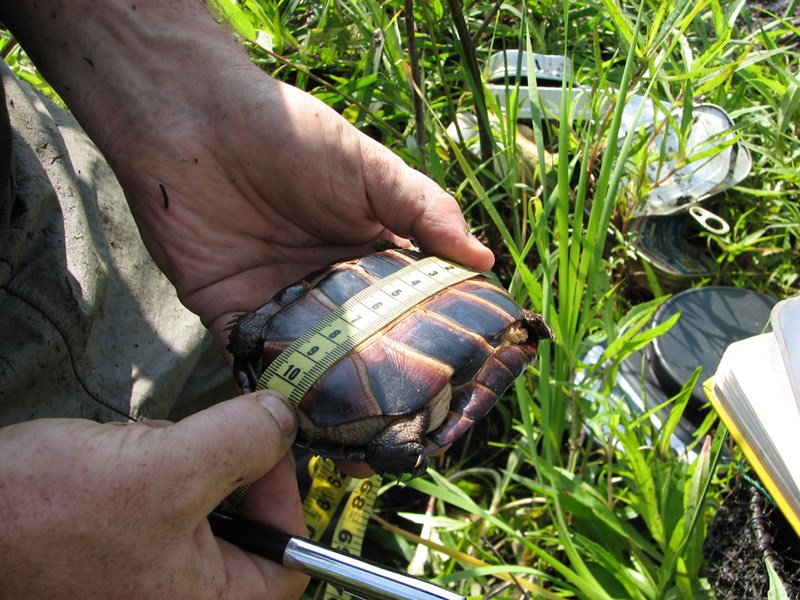Blanding's Turtle Recovery Program

Wildlife biologist measures the length of a Blanding’s turtle to track its growth.
The Blanding’s turtle (Emydoidea blandingii) is a long-lived, semi-aquatic turtle in decline throughout much of its range. The species was designated as endangered in the state of Illinois in 2009. Once likely common throughout Lake County, Blanding’s turtles have been documented from 17 localities since 1907. Of these, three populations are likely small and nonviable, 10 consist of only isolated observations or are relatively unknown, and one population has likely been extirpated due to habitat loss. Only one of the 17 known localities is currently known to contain both the number of animals and habitat needed to support a viable, free-ranging population of Blanding’s turtles—the Chiwaukee Illinois Beach Lake Plain (Lake Plain).
Along with our partners, we have been monitoring the Blanding’s turtle population within the Lake Plain since 2004. This large coastal area represents one of the largest and most well-studied populations of Blanding’s turtles in the region. However, modeling has indicated that the population is in decline due to low juvenile recruitment combined with unsustainable levels of adult mortality. In an effort to address the decline and recover the species, we instituted the Blanding’s Turtle Recovery Program in 2010. Learn more »
A viable, free-ranging population is defined as a population consisting of at least 50 adults that exhibits natural recruitment for at least two generations or 74 years. Natural recruitment is indicated by individual turtles reaching sexual maturity via natural means and unaided by management activities such as nest protection, head-starting or predator management. We have identified focal conservation areas (FCA) based on known population size (> 20 individuals) and the amount of nearby protected habitat (> 500 acres). Though three FCA were identified, we have recommended that conservation efforts be focused on the Lake Plain in northeastern Illinois and southeastern Wisconsin.
The Blanding’s turtle population contained within the Lake Plain is arguably the largest and most significant in the state and warrants the focus of management attention. Since 2004, 855 individual turtles have been documented in two sites within the larger coastal area, including 538 turtles that were released as part of a head-starting program. These two monitoring areas encompass only 530 of the roughly 5,000 acres (10.6 percent) protected within the entire FCA. As such, the population across the entire Lake Plain is likely significantly larger but is largely unknown, as little monitoring has been conducted within the remainder of the Lake Plain.
Despite the seemingly robust population size and abundance of habitat, modeling at one of the Lake Plain sites indicates that this population is in decline. The decline can be directly attributed to low survival rates for both juvenile and adult life stages. Data from 2004–2010, found only 7.7 percent of turtle nests hatched successfully without the aid of protection from predators. Annual adult survival was estimated to be 88 percent, which is well below the 95 percent believed necessary to sustain a long-term population. This means that not enough turtles are being produced on an annual basis to replace adults lost from the population. As such, we are monitoring to document population level changes and focusing conservation efforts to address these issues.
Fun Facts
-
Blanding’s turtles are long-lived and can attain ages of up to 80 years in the wild.
-
They have large home ranges. Females are known to travel up to two miles to find appropriate nesting locations.
-
Blanding’s turtles typically overwinter in muddy bottoms of deep marshes, backwater pools, ponds and streams.
-
They have delayed maturation, reaching sexual maturity at 14-20 years of age.
Field Guide
-
Medium-sized, semi-aquatic freshwater turtle.
-
Domed carapace (upper shell).
-
Carapace is dark and mottled with numerous yellow specks.
-
Bright yellow chin and throat.
-
Hinged plastron (lower shell) is yellow with dark blotches.
-
Hatchlings are dark brown to green in color.
-
Midwest/Great Lakes distribution.
-
Declining throughout range.
Where Do They Live?
Blanding’s turtles are considered semi-aquatic turtles and are dependent upon both wetland and open canopy upland habitat for survival. Females will travel great distances to lay eggs in dry, well-drained soils.
Blanding’s turtles occur from southeastern Ontario, adjacent to Quebec, and southern Nova Scotia, south into New England and west through the Great Lakes to Nebraska, Iowa and extreme northeastern Missouri.
Species Status and Threats
Blanding’s turtles were listed as threatened in Illinois in 1999 and as endangered by the Illinois Endangered Species Protection Board in 2009.
Why are they endangered?
-
High road mortality.
-
Illegal poaching and collection.
-
Loss of genetic diversity due to fragmented populations.
-
Habitat destruction or fragmentation; both wetland and upland habitats are important.
-
Increasing levels of nest predation by human-subsidized predators, such as crows, chipmunks, foxes, skunks and raccoons.
What We're Doing
PROGRAM GOAL
“To ensure long-term Blanding’s turtle persistence in Lake County through the management, conservation and/or re-establishment of viable, free-ranging populations of Blanding’s turtles at a minimum of three focal conservation areas.”
You can support the work of our wildlife ecologists to protect Blanding’s turtle populations. Join our Sponsor Our Turtles program. Any amount you can give helps local Blanding’s turtles thrive. Learn more »
MORE WAYS TO HELP
-
Do not feed raccoons and other wildlife.
-
Keep pet food and water dishes indoors.
-
Never release pets and risk spread of disease.
-
Do not bring wild animals inside as pets.
-
Keep cats indoors.
-
Conserve water; reduce use where possible.
-
Help prevent the spread of invasive species.
-
Volunteer to remove invasive species.
-
Drive carefully when near wetland areas.
-
Check for turtles under your car before driving away.
-
Support natural resources agencies (like us!).